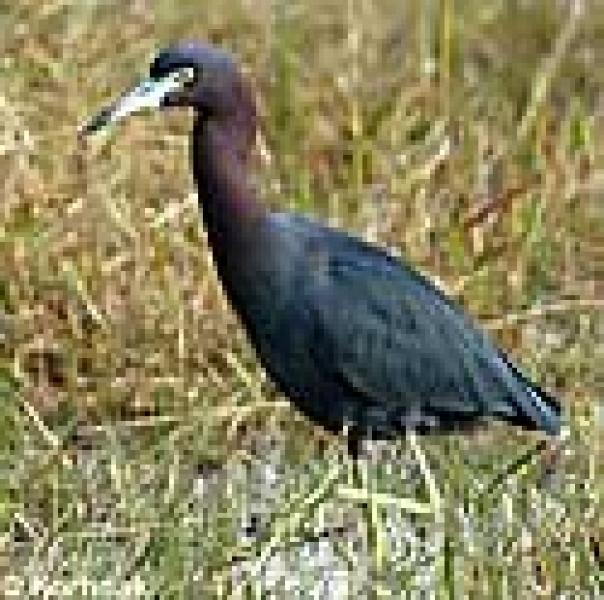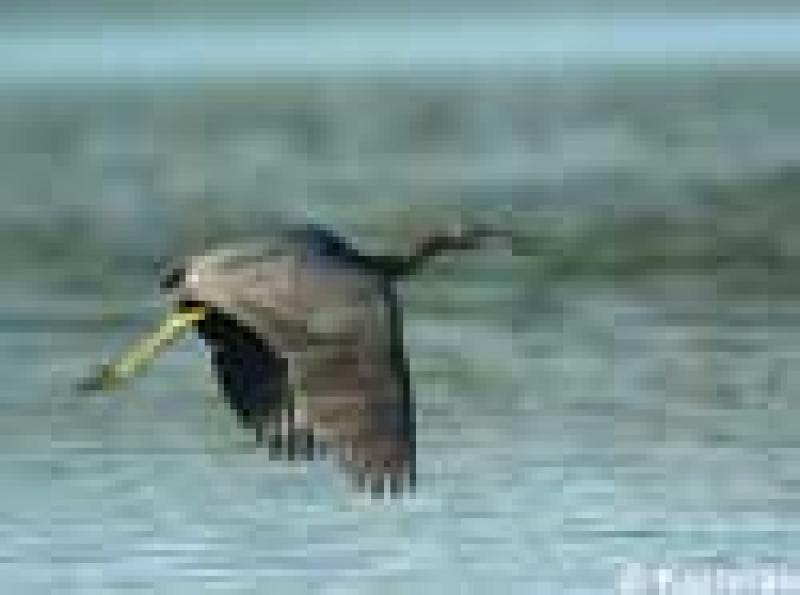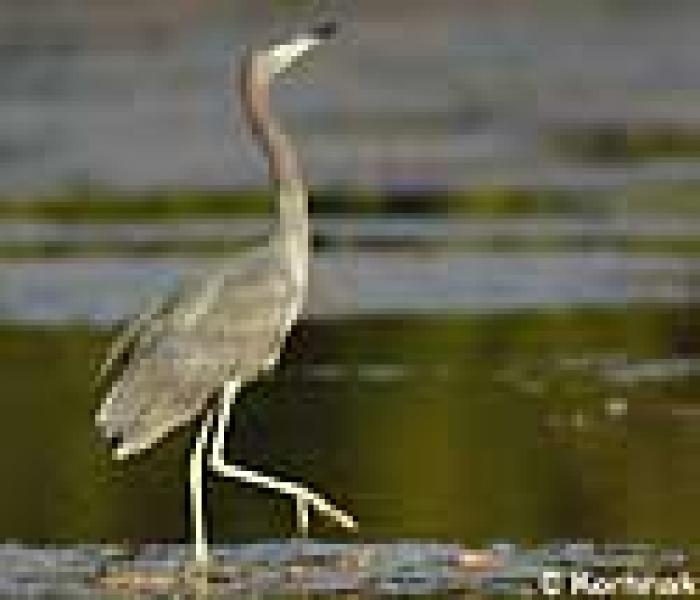Little Blue Heron
Egretta caerulea (Linnaeus, 1758)
- Class
- Aves (Birds)
- Family
- Ardeidae (Herons, Bitterns, and Egrets)
- State Protection
- Protected Bird
Defined as a Protected Bird by New York State law, and the species may not be hunted or taken at any time in New York. Includes birds also defined as a game species, but for which no open seasons are set.
- Federal Protection
- Migratory Bird Treaty Act
The Migratory Bird Treaty Act implements various treaties and conventions between the U. S. and Canada, Japan, Mexico and the former Soviet Union for the protection of migratory birds. Under this Act, taking, killing, or possessing migratory birds, including nests or eggs, is unlawful unless specifically permitted by other regulations.
- State Conservation Status Rank
- S2
Imperiled in New York - Very vulnerable to disappearing from New York due to rarity or other factors; typically 6 to 20 populations or locations in New York, very few individuals, very restricted range, few remaining acres (or miles of stream), and/or steep declines.
- Global Conservation Status Rank
- G5
Secure globally - Common in the world; widespread and abundant (but may be rare in some parts of its range).
Summary
Did you know?
Immature little blue herons are white.
State Ranking Justification
New York is near the northern limit of the little blue heron's breeding range. They are restricted to the non-barrier salt marsh islands of southern Long Island.
Short-term Trends
Breeding populations of little blue herons have been on a steady decline in New York. The 2007 Long Island Colonial Waterbird survey showed an average of less than 20 breeding pairs of herons at five of the 23 known colonies (McGowan and Corwin 2008; New York Natural Heritage Program 2009).
Long-term Trends
Accurate and historical survey data on little blue herons is lacking, partly due to their dark appearance making surveying difficult. Populations have been slowly declining throughout its range due to habitat loss. The little blue heron was an occasional visitor to New York during the late 1800s. They were first reported as breeding in the state during the late 1950s, on a salt marsh island in Jamaica Bay, Nassau County. By 1985, there were 68 breeding pairs in eight colonies. Confirmed breeding was recorded in 11 Breeding Bird Atlas blocks between 2000 and 2005 (McGowan and Corwin 2008).
Conservation and Management
Threats
Degradation of breeding and foraging habitat is the greatest threat to little blue herons (McCrimmon 2006). Other threats include flooding, development, disturbance of nesting areas by human activity such as boating, fishing, dredge spoil deposition, and predation primarily by gulls, fox, and raccoons (Rodgers and Smith 1995; New York Natural Heritage Program 2009).
Conservation Strategies and Management Practices
Continue to develop and conduct management and habitat restoration plans along with with state, local, and federal partners. Continue to monitor populations and discuss ways to improve survey methods. Compare state population trends against regional trends to determine population dynamics across various geographic areas and time periods. Consider developing and initiating a banding program to get a better handle on breeding populations and migratory patterns (Rodgers and Smith 1995; McCrimmon 2006).
Research Needs
More information is needed regarding life history and behavior in order to better protect this species. Research and identify key habitat characteristics necessary for breeding, foraging, and wintering areas. Identify all potential threats including those created by human disturbance as well as predators, pathogens, and invasive species, and seek ways to diminish their impact (McCrimmon 2006).
Habitat
Habitat
Little blue herons inhabit a variety of aquatic habitats, including lakes, ponds, rivers, and both salt and fresh water marshes. On the coast preferred habitats are salt marshes, ponds and mud flats. Wooded swamps, ponds and streams are utilized in inland situations. In New York, they utilize coastal salt marsh scrub/shrub islands; nesting in dense thickets or in trees. They forage in the estuaries surrounding these islands (Rodgers and Smith 1995; McCrimmon 2006; New York Natural Heritage Program 2009).
Associated Ecological Communities
- High salt marsh
(guide)
A coastal marsh community that occurs in sheltered areas of the seacoast, in a zone extending from mean high tide up to the limit of spring tides. It is periodically flooded by spring tides and flood tides. High salt marshes typically consist of a mosaic of patches that are mostly dominated by a single graminoid species.
- Low salt marsh
(guide)
A coastal marsh community that occurs in sheltered areas of the seacoast, in a zone extending from mean high tide down to mean sea level or to about 2 m (6 ft) below mean high tide. It is regularly flooded by semidiurnal tides. The mean tidal range of low salt marshes on Long Island is about 80 cm, and they often form in basins with a depth of 1.6 m or greater.
- Salt panne
(guide)
A shallow depression in a salt marsh where the marsh is poorly drained. Pannes occur in both low and high salt marshes. Pannes in low salt marshes usually lack vegetation, and the substrate is a soft, silty mud. Pannes in a high salt marsh are irregularly flooded by spring tides or flood tides, but the water does not drain into tidal creeks. After a panne has been flooded the standing water evaporates and the salinity of the soil water is raised well above the salinity of sea-water.
Associated Species
Range
New York State Distribution
Little blue herons breed on the non-barrier islands surrounding Staten Island and along southern Long Island, as far east as Gardiners Island (McGowan and Corwin 2008; New York Natural Heritage Program 2009).
Global Distribution
The breeding range of the little blue heron in the United States extends from southern Maine south along the Atlantic coastline to northern Florida, west to central Texas, north through Oklahoma to central Kansas, and east to southern Missouri, northern Arkansas, southern Illinois, and southwestern Kentucky. They breed casually in southern New Mexico and along the western coast of the United States. They also breed in the West Indies, along the coast of Mexico, and in South America in Peru, Colombia, Venezuela, the Guianas, and northern Uraguay. The winter range extends from southern Baja California east along the coasts of Mexico, Louisianna, Mississippi, and northern Florida to coastal Virginia (Rodgers and Smith 1995; NatureServe 2009).
Best Places to See
- Non-barrier islands north of Tobay Beach and Middle Hampstead Bay (Nassau County)
Identification Comments
Identifying Characteristics
The little blue heron is a small to medium-sized heron; about 60 cm in length with a wingspan of about 100 cm. Adults are slate blue in color. Legs are dark green and bill is pale with a black tip. During the breeding season, the head and neck turn a deep reddish-brown (Peterson 1980; National Geographic Society 1999). The birds nest in colonies with other species of herons. Nests are platform in shape, about 40 cm wide and 25 cm deep, and are constructed from dead twigs and sticks and lined with vegetation. They are formed in trees or shrubs 1-4 m from the ground. Four to five eggs are typically laid. The eggs are oval in shape, have a smooth shell, and are pale blue-green in color. The average size of the eggs is 44 mm x 44 mm (Bent 1926). Young are born pure white and resemble snowy egrets. They remain white typically until their first spring and gradually change over to blue (Peterson 1980; National Geographic Society 1999). The sub-adults with both white and blue plumage are often classified as calico or piebald (Rodgers and Smith 1995). Little blue herons have several different types of vocalizations. Nestlings and fledglings emit a food begging call that sounds like "hee-hee-hee". Typical adult vocalizations include those made breeding/greeting, that sounds like "Unh" and "Eh-oo-ah-eh-eh". When the birds are disturbed or show aggression, they make a "Sken" sound. They also produce nonvocal sounds such as bill nibbling which sounds like a rattle during courtship and bill snapping while exhibiting a stretch display (Rodgers and Smith 1995).
Characters Most Useful for Identification
The slate blue plumage and reddish-brown neck of the adults during breeding season are the most useful characteristics for identifying little blue herons.
Best Life Stage for Proper Identification
Adults in breeding plumage are the best stage for identifying this species
Behavior
Little blue herons arrive at their breeding grounds in early spring, and courtship, which is initiated by the males, begins soon after. Male birds walk throughout the colony, strutting, stretching, and snapping their bills. They establish their core territory which eventually becomes the nest site. Little Blue Herons are colonial nesters and often nest with other species of herons. Both the male and female aid in nest building, with the male gathering nest materials and the female doing most of the construction. Eggs are laid soon after the nest is constructed. The incubation period lasts around 22 days, with the male and female taking turns incubating. Hatching is asynchronous and occasionally results in mortality of younger chicks. The Little Blue Heron forages during the day in shallow water by wading very slowly and peering into the water, with the bill close to the surface. When prey is spotted, the head often sways in a semi-circle around the bill at the point of contact with the water just before striking (Willard 1977; Rodgers and Smith 1995).
Diet
Little blue herons forage in coastal marshes and estuaries for various types of fish, crustaceans, and other small invertebrates. The birds feed on regional species including minnows, anchovies, killifish, and darters, to name a few (Bent 1926; Rodgers and Smith 1995).
Best Time to See
Little blue herons can be found breeding on the non-barrier islands of Long Island from late May to August (Rodgers and Smith 1995).
- Active
- Reproducing
The time of year you would expect to find Little Blue Heron active and reproducing in New York.
Similar Species
- Snowy Egret (Egretta thula)
(guide)
Young and immature Little Blue Herons are frequently confused with immature Snowy Egrets. The immature herons have a pale bill with a dark tip and dark feet while the egrets have a dark bill and yellow feet (National Geographic Society 1999).
Little Blue Heron Images
Taxonomy
Little Blue Heron
Egretta caerulea (Linnaeus, 1758)
- Kingdom Animalia
- Phylum Craniata
- Class Aves
(Birds)
- Order Pelecaniformes
(Pelicans and Cormorants)
- Family Ardeidae (Herons, Bitterns, and Egrets)
- Order Pelecaniformes
(Pelicans and Cormorants)
- Class Aves
(Birds)
- Phylum Craniata
Additional Resources
References
American Ornithologists' Union (AOU). 1983. Check-list of North American Birds, 6th edition. Allen Press, Inc., Lawrence, Kansas. 877 pp.
Bent, A. C. 1926. Life histories of North American marsh birds. Bull. U.S. Nat. Mus. 135.
Bull, John. 1964. Birds of the New York area. New York: Harper and Row Publications 540 pp.
Bull, John. 1974. Birds of New York State. Doubleday, Garden City, New York. 655 pp.
Harrison, C. 1978. A Field Guide to the Nests, Eggs and Nestlings of North American Birds. Collins, Cleveland, Ohio.
McCrimmon, D.A. 2006. Species group report for colonial nesting herons. Pages 33-42 of Appendix A1, Species group reports for birds in: New York State comprehensive wildlife conservation strategy. New York Department of Environmental Conservation. Albany NY.
McGowan, K.J. and K. Corwin, eds. 2008. The Second Atlas of Breeding Birds in New York State: 2000-2005. Cornell University Press, Ithaca, NY. 688 pp.
National Geographic Society (NGS). 1999. Field guide to the birds of North America. Third edition. National Geographic Society, Washington, DC. 480 pp.
NatureServe. 2009. NatureServe Explorer: An online encyclopedia of life [web application]. Version 6.1. NatureServe, Arlington, Virginia. Available http://www.natureserve.org/explorer. (Accessed: January 18, 2009)
New York Natural Heritage Program. 2009. Biotics Database. New York State Department of Environmental Conservation. Albany, NY.
New York Natural Heritage Program. 2024. New York Natural Heritage Program Databases. Albany, NY.
New York State Breeding Bird Atlas. 1985. Final breeding bird distribution maps, 1980-1985. New York State Department of Environmental Conservation, Wildlife Resources Center. Delmar, NY.
New York State Department of Environmental Conservation. Checklist of the amphibians, reptiles, birds, and mammals of New York State, including their protective status. Nongame Unit, Wildlife Resources Center, Delmar, NY.
Palmer, R. S. (editor). 1962. Handbook of North American birds. Vol. 1. Loons through flamingos. Yale University Press, New Haven. 567 pp.
Peterson, R. T. 1980b. A field guide to the birds of eastern and central North America. Fourth Edition. Houghton Mifflin Co., Boston, MA. 384 pp.
Rodgers, J.A., Jr. and H.T. Smith. 1995. Little blue heron (Egretta caerulea). In The birds of North America, No. 145 (A. Poole, ed.). The Academy of Natural Sciences, Philadelphia, and The American Ornithologists' Union, Washington, D.C. Available: http://bna.birds.cornell.edu/bna/species/145 (accessed 10 July 2009).
Sauer, J.R., J.E. Hines, and J. Fallon. 2007. The North American breeding bird survey, results and analysis 1966-2006. Version 10.13.2007. US Geological Survey, Patuxent Wildlife Research Center, Laurel, MD.
Spendelow, J. A. and S. R. Patton. 1988. National Atlas of Coastal Waterbird Colonies in the Contiguous United States: 1976-1982. U.S. Fish and Wildlife Service, Biological Report 88(5). x + 326 pp.
Terres, J. K. 1980. The Audubon Society encyclopedia of North American birds. Alfred A. Knopf, New York.
Willard, D. E. 1977. The feeding ecology and behavior of five species of herons in southeastern New Jersey. Condor: Vol. 79, No. 4.
Links
About This Guide
Information for this guide was last updated on: January 23, 2012
Please cite this page as:
New York Natural Heritage Program. 2024.
Online Conservation Guide for
Egretta caerulea.
Available from: https://guides.nynhp.org/little-blue-heron/.
Accessed July 27, 2024.


